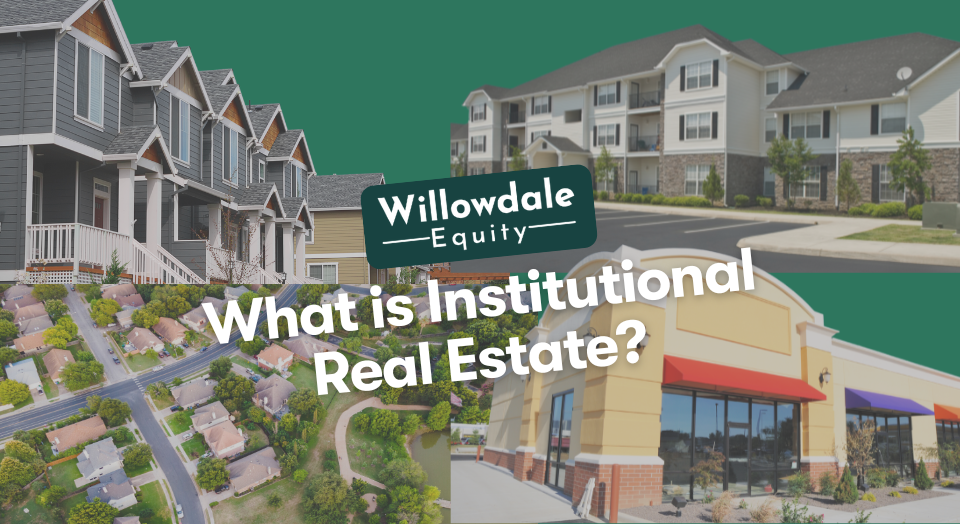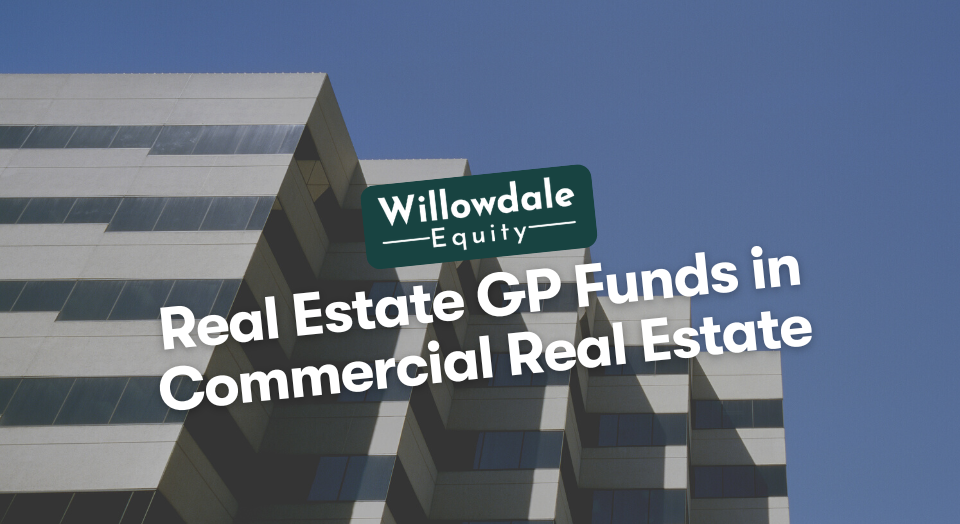
What is Institutional Real Estate? And Why the Definition is Rapidly Changing
This article is part of our passive investors guide on real estate syndications, available here.
The world of real estate investing is vast, complex, and frequently changes, requiring a basic level of knowledge to commit capital to any asset.
One change that we’ve seen is that new investment opportunities have arrived to transform real estate operations. Many of those operations involve institutional real estate.
What is institutional real estate, you ask? In this article, you’ll learn what these types of properties are and the details that make them institutional grade. Keep reading to learn more about these properties and why they matter to new real estate investors.
Key Takeaways
-
Institutional real estate refers to properties of sufficient size and stature to draw the attention of significant national or international investors.
-
The term institutional quality tends to be a high-quality trophy asset located in central areas of primary markets, also referred to as Class A properties.
-
A stabilized real estate investment consists of a property that has been fully constructed or renovated and is fully occupied, generating solid operating income that can comfortably support its debt service.
Institutional Real Estate Definition
Institutional real estate refers to properties of sufficient size and stature to draw the attention of significant national or international investors. They also attract the interest of high net-worth individuals, pension funds, foundations, insurance companies, hedge funds, and investment banks, among others.
In a more general understanding, you can look at Institutional real estate as a particular real estate category. This real estate category includes commercial assets like retail, industrial, logistics, student housing, senior living, and multifamily. However, institutional investors are increasingly choosing to buy other types of assets as newer alternatives, which include real estate such as data centers and self-storage facilities. These, too, fall under the umbrella of institutional real estate.
It’s important to note that the evolution of the concept of institutional real estate has meant that intelligent investors have chosen to broaden their vision of what an institutional quality asset is. As a result, there are opportunities that, over the years, investors have overlooked because they don’t fall into that box.
As a result, institutional real estate’s definition has broadened beyond Category A real estate. To fully understand what now falls under this umbrella, it’s important to look at some of the main characteristics of institutional real estate properties.
Characteristics of Institutional Quality Commercial Real Estate
However, institutional real estate investors can look at a few fundamental characteristics to help them select institutional investment properties and the values of these properties typically exceed tens of millions of dollars.
But, at the same time, their capitalization rates are relatively low, typically between 3 and 5 percent.
Many institutional real estate investments aim for a low-risk investment strategy, so they are willing to assume lower returns on a single asset by acquiring lower-risk stabilized assets in highly liquid markets. They are also willing to pay more for these assets, greatly reducing capitalization rates.
Let’s take a closer look at these three core characteristics of institutional real estate and how they affect these investments.
Strong Areas in Strong Markets

The term institutional quality tends to be a high-quality trophy asset located in central areas of primary markets, also referred to as Class A properties. Class A properties are larger with minimal risks of becoming obsolete or losing value.
Trophy properties are characterized by high demand, a strong location, and other quality elements that allow the asset to appreciate in value over a longer period. These class A properties are primary employment centers without considering market fluctuations.
However, these are not the only types of properties included in institutional real estate. There are also larger properties to consider when it comes to these types of commercial real estate, as we will see below.
Larger Sized Deals
The institutional real estate industry focuses on markets beyond the reach of the masses and is directed more towards those investors with excellent financial capabilities, pension funds, and other strong assets.
These pension funds and other entities invest billions in real estate and have access to investments that the general public doesn’t.
For example:
- A 500-unit multifamily property in the heart of Miami
- A historic office building in the heart of Manhattan
- A portfolio of 5,000 single-family homes across the Southeastern U.S.
An institutional investor seeks to enlarge the scale of their acquisitions by grouping a significant amount of real estate that adds up to a sufficient number of assets or by simply acquiring larger priced assets every time they transact.
Considering the above, we must remember that this type of commercial real estate is often a stabilized, low-risk real estate investment. As a result, they’re attractive despite their high cost and large size as they help ensure that an institutional investor won’t engage in overly high levels of risk.
Stabilized Low-Risk Assets
A stabilized real estate investment consists of a property that has been fully constructed or renovated and is fully occupied, generating solid operating income that can comfortably support its debt service.
This type of institutional quality real estate is attractive to institutional investors given the risk reductions in all operational aspects, allowing capital to maintain fluidity. As a result, institutional investors earn consistent yield while preserving their capital.
Let’s look at an example of an institutional quality real estate asset like a multifamily property.
Related Read: Property Funds vs. REITs
An Example Institutional Quality Commercial Real Estate Asset

A good example of an institutional quality real estate asset would be a 308-unit Class A multifamily property in the heart of Boston, MA.
Among the characteristics of the investment are:
- $400,000 price per unit or $123,200,000 for this 308-unit property.
- A 3-acre piece of land located in a prime area of Boston with many attractions
- Newly constructed in 2020 and boasts a strong community amenity package that includes a pool, business center, rooftop terrace, fitness center, and communal rooms.
- High average rents of $2,500.
- Strong 1-mile demographics, $300,000 median income, and less than 4.7% unemployment.
- Submarket vacancy of only 4%.
This would be considered one of the investor’s institutional quality assets in a real estate portfolio. It is located in a strong area in a strong market. Additionally, it is a large property with a high value, giving it the larger size characteristic of institutional real estate.
Finally, this property is fully occupied, making it a stabilized, low-risk asset.
While this is a strong example of a multifamily piece of institutional real estate, single-family real estate can also be classified as institutional property. Let’s take a look at why that’s becoming the case.
Why Single Family is Becoming an Institutional Asset

Buying single-family homes on a large scale has become a trend. Institutional investors have begun to ramp up their buying spree at the beginning of the Covid-19 pandemic.
Although savvy investors seek the operational efficiencies and scale that come with acquiring larger assets, the migration of institutional real estate has promulgated and promoted a new way of generating cash flow through investment in single-family properties en masse.
Institutional investors saw an opportunity in these properties for many reasons, such as the low housing supply and the rising cost to build, making as-is-built properties more valuable.
Also, institutions are savvy and have a strong grasp of macroeconomics. It was evident to them that the federal reserves’ move to employ quantitative easing through mass money printing would erode the dollar’s value and increase the value of hard assets like real estate. However, this institutional tendency to acquire these properties has made it difficult for normal buyers of single-family rentals to operate in the market.
The market has also grown thanks to low supply and high demand, historically low-interest rates, and the relocation of many individuals and businesses from high-tax to low-tax states.
Frequently Asked Questions About Institutional Real Estate Investment
Yes, REITs or Real Estate Investment Trusts are institutional investors since these groups seek to invest in large national or international properties and high-quality class A properties located in primary markets.
Institutional grade real estate is large properties located in primary markets that attract the attention of investors with great capacity and wealth. These properties are largely inaccessible to the average investor due to the high cost and size of the investment.
Institutional Real Estate - Conclusion
Institutional Real Estate has worked for years with the premise of acquiring properties of high quality, size, and value in markets with characteristics of strong economic drivers and high liquidity.
However, these institutions are changing thanks to the new opportunities offered by the real estate market and have begun to venture into smaller-scale investments that still involve a large amount of capital.
If you’re interested in learning how to invest your capital passively but still don’t know how or what type of real estate, join the investor club today. Joining gives you access to our resources and private multifamily investing opportunities.
Sources:
- Alpha Investing, “A Broader Definition of “Institutional-Quality” Real Estate“
- Arbor Crowd, “Can a stabilized real estate asset yield strong returns?”
- Commercial Observer, “Nearly One in Five US Homes Sold in Q4 2021 Bought by Institutional Investors“
Interested In Learning More About PASSIVE Real Estate Investing In Multifamily Properties?
Get Access to the FREE 5 Day PASSIVE Real Estate Investing Crash Course.
In this video crash course, you’ll learn everything you need to know from A to Z
about passive investing in multifamily real estate.
We’ll cover topics like earned income vs passive income, the tax advantages, why multifamily, inflation, how syndications work, and much much more!




